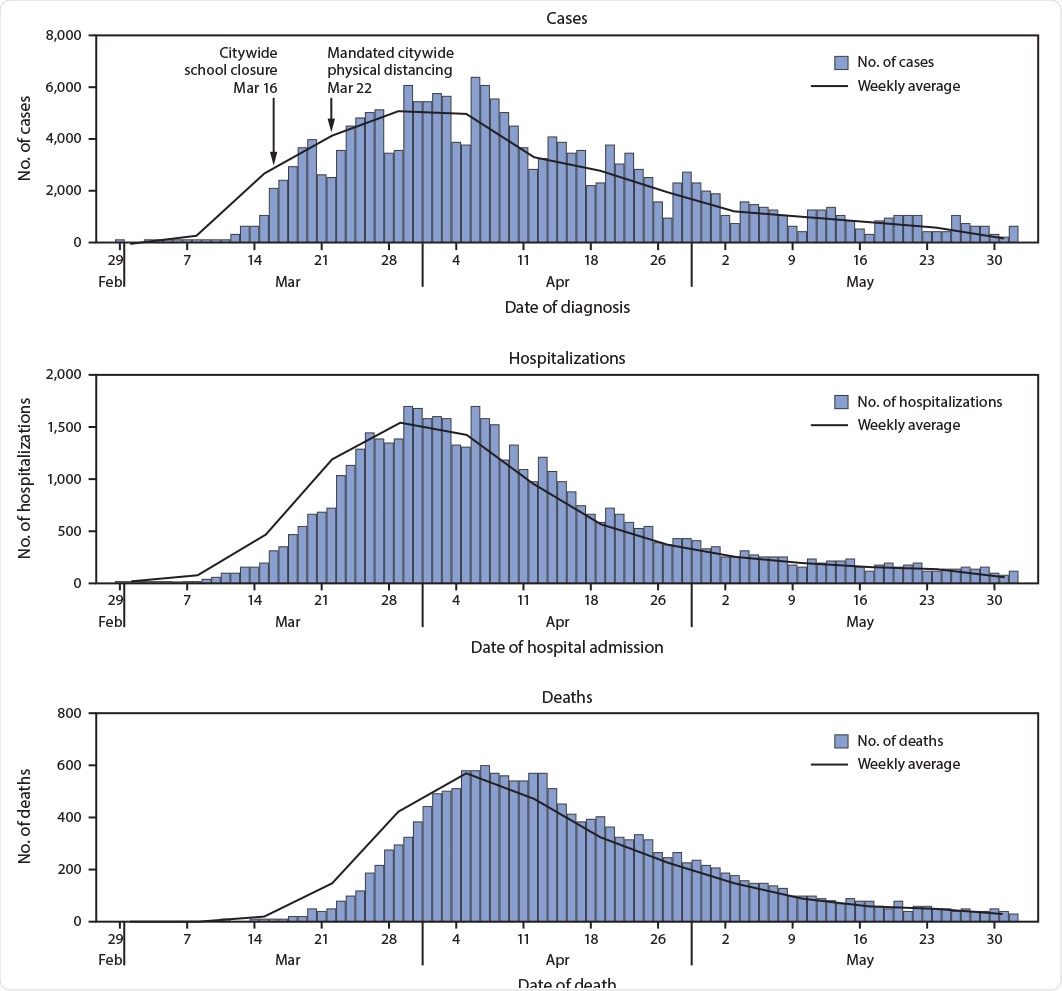The COVID-19 pandemic caused by the severe acute respiratory syndrome coronavirus 2 (SARS-CoV-2) has infected over 59 million people worldwide and claimed more than 1.39 million lives. The United States alone has seen over 12.37 million cases since the beginning of the pandemic, with over 257,000 deaths.
The Centres for Disease Control and Prevention (CDC), in its Morbidity and Mortality Weekly Report (MMWR), has published an update on the outbreak in New York City. The report is titled, "COVID-19 Outbreak — New York City, February 29–June 1, 2020".
Need for this report
Since the start of the pandemic, New York City (NYC) has been the "epicenter" of the USA outbreak, says the report. The researchers write that between March and May 2020, there have been nearly 203,000 cases of COVID-19 confirmed by reverse transcription-polymerase chain reaction (RT-PCR) testing, according to the data from the NYC Department of Health and Mental Hygiene (DOHMH).
The authors write that data such as this from NYC can provide a blueprint to other jurisdictions with similar statutes to devise plans to prevent human to human transmissions and bring the outbreak under control.

Daily laboratory-confirmed COVID-19 cases, associated hospitalizations, and deaths — New York City, February 29–June 1, 2020
Highlights from NYC
The DOHMH also used additional information sources to compile the patients' data, their hospitalization status, rates of deaths, etc. The main highlights were the concentration of the cases in "communities of color, high-poverty areas, and among persons aged ≥75 years or with underlying conditions." The crude fatality in NYC was found to be 9.2 percent overall and 32.1 percent among those hospitalized.

Cumulative crude rates of COVID-19 testing per 100,000 population, percentage of tests positive for SARS-CoV-2, and cumulative crude rates of COVID-19 cases per 100,000 population,* by modified ZIP code tabulation areas — New York City, February 29–June 1, 2020
Testing and reporting
This report shows the following findings from NYC:
- The DOHMH began COVID-19 surveillance in January 2020.
- The NYC and New York State public health laboratories started testing for COVID-19 by the end of February.
- Those with mild symptoms were asked to stay at home in isolation to spare the hospitals due to "shortages of personal protective equipment (PPE) and laboratory tests at hospitals and clinics."
- Between February 29 and June 1, 2020, the reports were documented by the DOHMH.
- On April 14, the DOHMH first reported COVID-19–associated deaths (i.e., no known positive SARS-CoV-2 test result and death certificate listing cause of death as COVID-19 or an equivalent term).
- DOHMH added additional information of the patients, including "race/ethnicity, and presence of underlying medical conditions, including diabetes, lung disease, cancer, immunodeficiency, heart disease, asthma, kidney disease, gastrointestinal/liver disease, and obesity," wrote the researchers
- Crude rates of cumulative cases, deaths, and testing per 100,000 population were assessed.
Findings
Overall findings over the study period were:
- During February 29–June 1, 2020, a total of 203,792 COVID-19 cases were diagnosed and reported
- 54,211 (26.6 percent) were hospitalized
- 18,679 (9.2 percent) died due to COVID-19
- There were 2,263 cases, 582 hospitalizations, and 198 deaths per 100,000 population
- 274 cases were diagnosed each day per week on average during the week of March 8. This rose to a peak of 5,132 cases per day per week on average by the week of March 29.
- Hospital admissions peaked the week of March 29 (average 1,566 admissions per day)
- Deaths peaked during the week of April 5 (weekly average 566 per day)
- The median duration of hospitalization was 6 days (range 3 to 11 days)
- Among hospitalized patients, 32.1 percent died
- The weekly proportion of hospitalized patients who died was most significant at 36.4 percent on average between March 22 and April 5
- The highest number of cases were seen in the age between 45 and 64 years (7,007 per 100,000)
- Hospitalization and death rates were highest among patients aged over 75 years (2,146 and 1,311 per 100,000, respectively)
- Deaths were more in males and among those living in poor neighborhoods.
- The highest death rates were from the Bronx and the lowest in Manhattan
- The highest death rates were among Black/African American (Black) persons (1,590 per 100,000)
- Most patients had two or more underlying conditions
- During March 11 and June 1, 4,516 probable COVID-19–associated deaths were reported
Conclusions and implications from the report
This report paints a picture of the pandemic and its peak early in 2020. Authors wrote that deaths and complications were greatest among "Black/African American and Hispanic/Latino persons, as well as those who were living in neighborhoods with high poverty, aged ≥75 years, and with underlying medical conditions."
The researchers called to attention the "barriers to accessing testing in areas with considerable community transmission. Mitigating future morbidity and mortality from COVID-19 across NYC in the absence of a vaccine, particularly among persons who are at increased risk, is an urgent priority."